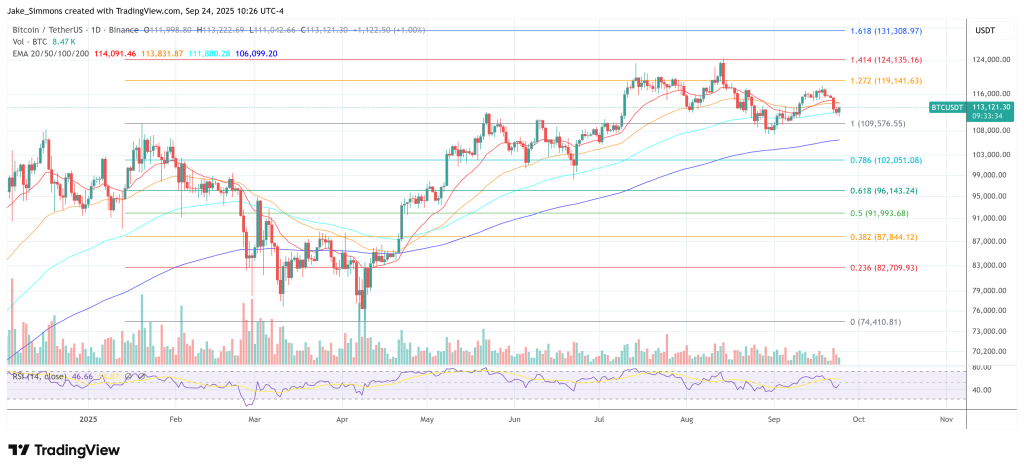A widely followed crypto analyst known as plur daddy (@plur_daddy) has emerged again, presenting a macro viewpoint that positions Bitcoin and gold at the heart of an impending policy shift—asserting that President Donald Trump’s initiative to gain more control over US monetary policy could trigger a liquidity surge that harms the dollar and compels institutional investment in alternative assets.
These comments come as global policymakers deliberate the potential use of Russia’s frozen reserves to support new loans to Ukraine, with gold nearing record prices, establishing a market landscape where Bitcoin is increasingly influenced by liquidity and institutional trust rather than a halving-related “four-year cycle.”
Trump’s Fed Control Could Ignite Bitcoin
“It’s been refreshing to be off Twitter… I remain bullish on BTC and have also significantly increased my gold holdings since August. This is due to my conviction that Trump’s attempts to take command of the Fed represent a significant catalyst, akin to those that occur once every decade,” he noted, adding: “Once he gains control, it’s reasonable to expect not only rate cuts but some form of yield curve management… The USD will inevitably suffer.”
Related Reading
The article positions Bitcoin and gold as “the purest beneficiaries of a scenario where liquidity is rising and institutional trust is waning,” arguing that enduring anxieties about a halving-related market peak are misplaced since “BTC… has been integrated into traditional finance and is a more accurate reflection of liquidity conditions.”
The policy environment he describes has transitioned from theoretical to actively debated in recent times. Federal Reserve Chair Jerome Powell has openly denied allegations of political motivations behind the central bank’s actions, even as market participants analyze appointments and external pressures from the White House.
“Cheap shots,” he remarked regarding allegations about the Fed’s intentions, justifying the data-driven nature of recent decisions. Concurrently, global leaders and market analysts are discussing whether continued political involvement could lead the Fed toward explicit yield-curve control to manage long-term borrowing rates—an approach not employed in the US since the 1940s.
In a subsequent thread, “plur daddy” detailed a plan for lowering mortgage rates by having government-sponsored enterprises (Fannie Mae and Freddie Mac) acquire more mortgage bonds, using capital requirement adjustments and derivatives for duration management.
This approach is distinct from quantitative easing by adjusting spreads through asset composition rather than directly enlarging central bank balance sheets. The argument ties into broader political motivations ahead of the US midterms: “Markets are forward-looking… They have a strong incentive to stimulate the economy and markets,” he asserted, warning that direct fiscal measures could be inflationary.
The liquidity focus also pertains to the Treasury General Account (TGA), which has been rapidly replenished into late Q3. Analysts had cautioned that aggressive TGA refills into September might temporarily strain market liquidity before easing, a pattern closely monitored by crypto traders due to Bitcoin’s heightened sensitivity to fluctuations in dollar reserves and the dynamics between bills and reserves. “BTC is extremely responsive to any change in liquidity conditions, much more so than stocks,” the article claims, reflecting analysis that connected TGA movements to risk asset performance.
Another key aspect of the thesis involves Europe’s shifting approach to Russia’s frozen assets—approximately $300 billion that have been immobilized since the 2022 invasion. The EU is considering a structure where new loans to Kyiv are secured by these assets, repayable only if Russia compensates—an outcome the author believes “will never materialize,” describing the mechanism as a de facto appropriation that “significantly enhances the rationale for crypto.”
Related Reading
The market backdrop has been favorable for the store-of-value argument. Gold has reached new peaks this month, with several banks forecasting scenarios approaching $3,700–$4,000 in the coming quarters if central banks continue to buy—potentially higher if private investors increase hedging activities against US dollar assets amidst policy and geopolitical unpredictability. “It is logical that BTC would start moving [when] gold’s momentum begins to wane,” “plur daddy” remarked, suggesting a shift once bullion’s rise slows.
The post has quickly gained support from prominent traders. “Agreed, I’m trying to time this, I expect < 6 months & > 90k,” wrote Ansem (blknoiz06), indicating a timeline that suggests a Q1 2026 timeframe for another Bitcoin surge. Macro strategist Alex Krüger praised it as a “great post.” Forward Guidance podcast host Felix Jauvin added: “So exceptionally expressed. Good to see you, man.”
The policy landscape the expert outlines now features a Federal Reserve Board with a newly confirmed Governor, Stephen I. Miran, who promptly dissented at the September FOMC meeting for a larger rate cut, advocating for significantly accelerated easing in the dot plot.
Simultaneously, the administration’s effort to remove Governor Lisa Cook through litigation has highlighted the legal protections surrounding Federal Reserve autonomy. These developments—alongside Europe’s evolving plans to utilize frozen Russian assets—serve as tangible indicators of the “once-in-a-decade” moment referenced above.
As of the latest update, BTC is trading at $113,121.

Featured image created with DALL.E, chart from TradingView.com

